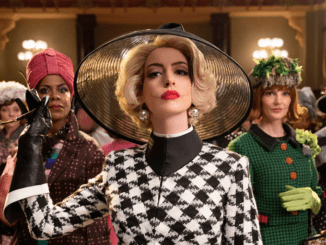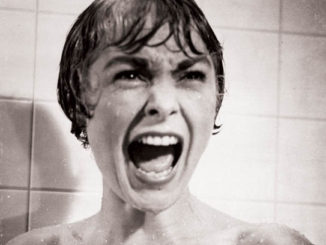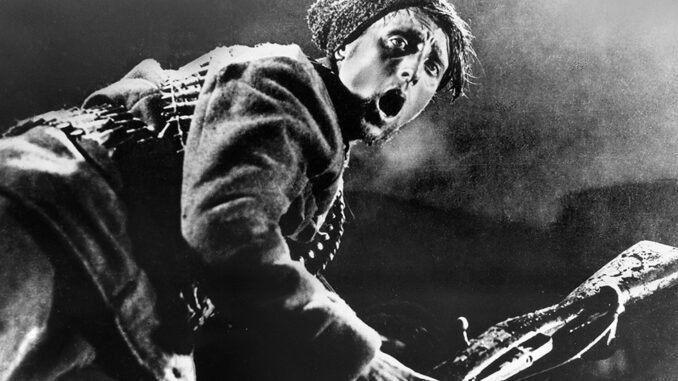
by Edward Landler
After 90 years, the premiere of Sergei Eisenstein’s October on November 7, 1927 at Leningrad’s Bolshoi Theatre still endures as the most famous screening of an unparalleled motion picture epic that was never shown publicly in its entirety.
Exactly a decade earlier, in what is now called St. Petersburg, the Bolsheviks, led by Vladimir Lenin, overthrew Alexander Kerensky’s short-lived Russian Provisional Government after the deposition of Czar Nicholas II. But, in 1917, November 7 was still October 25 — Lenin’s government dropped the nation’s traditional Julian Calendar to adopt the modern Gregorian Calendar in 1918, shifting the date 13 days forward.
Thus, on the very day of the 10th anniversary of the October Revolution that established the Union of Soviet Socialist Republics (USSR), the invited audience of Communist hierarchy came to the Bolshoi. They were eager to see two feature-length films produced for the national celebration, starting with the internationally renowned director’s re-creation of the glorious event, only to be shown three reels hastily selected for the occasion. This unexpected screening of only a portion of Eisenstein’s film was followed by Vsevolod Pudovkin’s The Fall of St. Petersburg, the other movie produced for the occasion, in its entirety.

Earlier that day, General Secretary of the Central Committee of the Communist Party (hence, dictator of the Soviet Union) Josef Stalin, had previewed the entire October in Eisenstein’s cutting room. After watching it, he ordered over 3,500 of its 13,000 feet cut, more than a quarter of its length.
Grigori Alexandrov, assistant director on Eisenstein’s first two films, Strike and The Battleship Potemkin (both 1925), and credited as co-writer/co-director on October, told The New York Times in 1963, “When Eisenstein and I asked why the cuts had to be made, Stalin said evasively, ‘You don’t know what is going on. This is not the right time for Lenin’s liberalism.’”
Over the next four months, while Eisenstein, Alexandrov and editor Esther Tobak cut October from 142 to 103 minutes for its March 14, 1928 Soviet release, the power struggle within the party that motivated the General Secretary’s cuts would become obvious, as will be related below. And Stalin’s oppression would belie the idealistic Eisenstein’s purpose in his work, as stated in the director’s article for the Soviet film journal Kino, written while re-editing: “Posterity must have a photographic reproduction of the great Revolution, a living textbook for the inspiration of other inspirations.”
In October, more than in any other of his films, Eisenstein powerfully demonstrated scene-by-scene and sequence-by-sequence an extraordinary range of possibilities for evoking meaning through editing images. In retrospect, as applied to the movie’s themes of political power, his “montage of attractions” — as the director called his approach to editing in Film Form: Essays in Film Theory, published in 1949 — consistently underscores the suggestion that a change of government or ideology may only be a substitution of one authoritarian hierarchy for another.
In October 1926, in preparation for the anniversary, the Central Committee commissioned the two leading Soviet film trusts to produce movies to commemorate the historic event. Eisenstein’s trust, Sovkino, asked writer/director/editor Esther Shub to create a documentary film using the official government film and photographic archives to depict the revolution.
The second major trust, Mezhrabpom, assigned director Pudovkin — acclaimed for his first feature Mother (1926), an adaptation of Maxim Gorki’s novel about the failed 1905 Revolution — to produce a dramatic feature. Working from a script by Nathan Zarkhi entitled Petersburg, Petrograd, Leningrad (the successive names of the title city over the time of the film’s action), Pudovkin would create The Fall of St. Petersburg, already scheduled to premiere at the Bolshoi on the anniversary night itself, November 7.
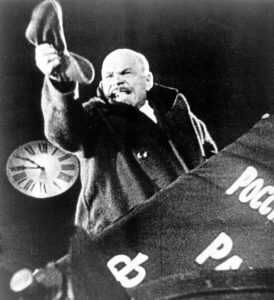
When Sovkino learned that Mezhrabpom’s Pudovkin was making a film for the anniversary, the trust immediately told its star director Eisenstein to cease his prep for The General Line (about agricultural cooperatives) to create his own movie about the October Revolution. While Pudovkin’s film followed one young man from 1914 on to tell the story of the revolution, Eisenstein chose to reconstruct the revolution in Petrograd by telling the story of a mass of individuals with no central character — as he had done in both Strike and Potemkin.
Friendly rivals, the two most prominent Soviet directors argued about the essential function of film editing. As Eisenstein noted in Film Form, Pudovkin described montage in a film story as a “linkage of shots…bricks arranged in a series to expound an idea.” Eisenstein instead characterized editing as a “collision of shots” out of which “arises a concept.” For him, linkage was “a possible special case.”
Announcing a January 1, 1927 shooting start — less than three months away — to be ready for the November 7 premiere, for which October was now also scheduled, Eisenstein and his trusted collaborator Alexandrov set to work on a script covering the events from March through October 1917. Incorporating the director’s extensive notes for its editing, the scenario virtually became a written pre-visualization of the entire film. The filmmaker consciously planned for the imagery to work on several concurrent levels, allowing him to interrupt the action to create metaphoric montages fusing ideas with emotion.
Eisenstein’s team drew from hundreds of personal memoirs, newsreels, interviews and newspaper accounts, as well as American journalist John Reed’s landmark eyewitness account in his 1919 book, Ten Days That Shook the World. Re-creations of these materials echo throughout October; they triggered Eisenstein’s conception and visualization of montages, adding ironic insight and humor into the very human motivations at the heart of the struggles depicted.
Perhaps an even more significant factor contributing to his overall perspective was the director’s intimate knowledge of the city itself from the very time portrayed in the film. In 1910, the 12-year-old Eisenstein came with his family to live in St. Petersburg. In 1917, as a student of architecture and engineering, he witnessed some of the actual events re-created in his epic. The future filmmaker grew familiar with the physical details of the city’s distinctive landmarks, including the lavish interiors of the Winter Palace — details he now planned to weave into his editing to create both structural unity and rhythmic counterpoint.
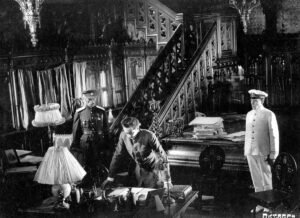
For casting actors, the director sent his assistants out to the streets to find ordinary individuals by employing what he called “character typage.” Assistant director Maxim Strauch told French film historian Georges Sadoul in 1960, “We ended up with a thick, illustrated notebook [of potential actors] filled with comments by Eisenstein.” Akin to the stock characters of commedia dell’arte, the filmmaker derived the concept from his work in the early 1920s with Moscow’s Proletkult (Proletarian Culture) theatre group.
To play the recognizable historical figures, however, Eisenstein found non-actor exact doubles — a cement factory laborer played Lenin; a student portrayed Kerensky. A consultant on the film, former chair of the Military Revolutionary Committee Nikolai Podvoisky, agreed to play himself; many of those he led in the storming of the Winter Palace served under him again for the movie.
The sheer magnitude of preparation forced the January start date to be postponed. The script was completed late in March and production began April 13. With a precise shooting plan for filming entirely on the original locations over six months, the production had the whole city of Leningrad at its disposal. To meet the premiere date, Eisenstein and Alexandrov decided to shoot scenes separately in different locations simultaneously.
Supported by large camera and lighting crews, cinematographer Eduard Tisse divided his time between the parallel shoots. For lighting night scenes, though, the city could not generate enough electricity for both its inhabitants and the film. Over the several nights it took to shoot the taking of the Winter Palace, almost every other section of the city was plunged into darkness.
In a November 1927 article for the American magazine The Nation, Eisenstein stated that the Soviet government also “supplied the arms and uniforms, as well as the army. The state lent us the [battleship] Aurora… Likewise, we had the use of tanks and artillery.” The filmmaker estimated that 5,000 organized workers participated in the scene of the mass shooting of demonstrators on the Nevsky Prospect and in the battle for the Winter Palace. Alexandrov told historian Sadoul that, including actual Red Army soldiers, close to 11,000 extras were employed in the Winter Palace shoot.
In addition, Eisenstein and Pudovkin both shot their films for the 10th anniversary at the same time and in the same places. As the latter told British film critic Ivor Montagu, “I bombarded the Winter Palace from the Aurora while Eisenstein bombarded it from the Fortress of St. Peter and Paul…”
While October’s co-directors rushed to finish shooting, editor Tobak diligently cut their footage in accordance with the scenario’s voluminous editorial directions. With barely three weeks left before November 7, production wrapped in mid-October, and Eisenstein and Alexandrov joined her to complete post-production in time for the premiere, which they did.
After only three reels of October were premiered at the Bolshoi, Eisenstein took the blame for the “unfinished” film’s delay in an article he wrote for the Soviet film journal Kino. Noting the late start of production and a later start of editing than anticipated, he explained, “The film was not orientated to the 10th anniversary alone… It was calculated to show us, every and any day, the living and permanent jubilee of the October victory!”
Yet anyone (including the filmmakers) aware of the crisis then erupting in the Communist Party might have guessed the meaning of Stalin’s ominous remark about “Lenin’s liberalism.” The rivalry between the government led by Stalin and an opposition group led by the acknowledged military hero of the revolution, Leon Trotsky, had turned to open hostility — especially after Trotsky was expelled from the Politburo, the policy-making board of the Central Committee.
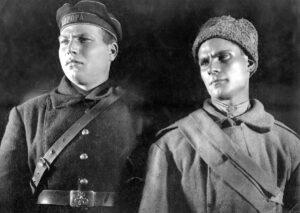
On October 23, the week after the film had wrapped, Trotsky led a demonstration in Leningrad denouncing the Stalinist bureaucracy; four days later, he was dumped from the Central Committee itself. Viewing the film on November 7, Stalin saw Trotsky and the other opposition leaders (all portrayed by doubles) unmistakably depicted as prominent in the revolution; Stalin was not depicted at all, since he had been in Moscow during that time.
The preview of the three reels for the anniversary was approved by Stalin because none of the opposition leaders appeared in those reels. The 3,500 feet ordered to be cut — and destroyed — eliminated their presence in the film entirely, except for two sequences with Trotsky. In one of those scenes, a title card now noted that he disagrees with Lenin.
On November 27, Trotsky was expelled from the Communist Party. On January 31, 1928, while Eisenstein was completing the hardest of the “purely editorial work” on his film for its March 14 Soviet release in its re-edited form, Trotsky was exiled to Kazakhstan and, in 1929, from the Soviet Union. After completing the truncated October, the filmmaker returned to work on The General Line, released in 1929 as Old and New.
Over 1928 and 1929, October was released outside the Soviet Union (with nine more minutes excised by the foreign distributors) as Ten Days That Shook the World, from the title of Reed’s book. The intricacy of Eisenstein’s editing, more complex than that of any film up to that time, confused many audiences, but its power and originality could not be overlooked. It was cited by a German critics association as the Best Film of 1928 and, in the US, was named one of 1929’s Best Foreign Films by the National Board of Review.
In the USSR, the Communist Party critics pronounced October a failure. The 1932 edition of the Soviet Encyclopedia later summed up the official judgment: “Eisenstein, despite his great skill, failed to make a profound analysis of the decisive stages of the Socialist Revolution and was lured off the track by formalist experimentation.” Party critic and magazine editor Timofei Rokotov wrote in International Journal, “…for an objective picture of the historic events of the Great October Revolution, he substituted his own individual, subjective reactions.”
Nonetheless, Lenin’s revered widow, Nadezhda Krupskaya, openly praised the film in Pravda, the official party newspaper, writing, “Now an art is emerging that depicts the fundamental experiences of the masses. October is a fragment of this art of the future.” And Eisenstein’s great rival Pudovkin told literary critic and screenwriter Viktor Shklovsky, who recalled the statement in his 1966 memoir, Once Upon a Time, “How I should like to make such a powerful failure.”
To this day, the influence of October on movies as a whole is difficult to define. Conceived as both narrative and exploration of the elements of film, it stands alone as a bountiful vocabulary of the resources offered by the composition and editing of visual imagery. Yet, it is nearly impossible to view almost any engaging film from any era or country without observing some vital aspect of cinema touched upon by Eisenstein’s film: the striking pictorial effect, the bravura moment of editing finesse, the evocative response to human emotional expression.



